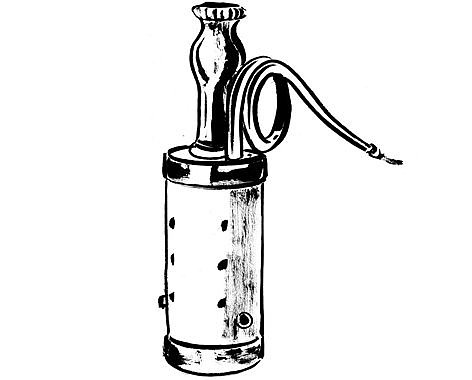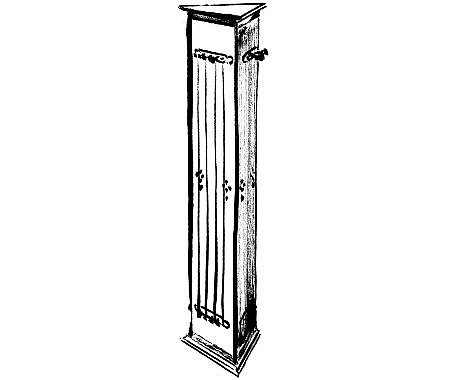Bereichsnavigation
Curiosities
The history of musical instrument making includes many examples of rare and wondrous inventions. Pay a visit to our virtual cabinet of curiosities!
Sausage bassoon and a trumpet in a can
The bores of wind instruments are often quite long. In the seventeenth century, instrument makers had a clever solution – put them in a can!
Today, there are only a few preserved specimens of the wind instrument known as the ranckett (also called rackett). Used chiefly in the seventeenth century, it has the shape of a large can. The bore inside is arranged in a zig-zag pattern around a vertical axis, so that its length is more than nine times the height of the can. This folded bore is reminiscent of a sausage, which is why the ranckett is sometimes called a sausage bassoon. In addition to sounding like a bassoon, it also has the bass register and double reed of that instrument. Etymologically, the word ranckett probably has its origin in the Upper German word rank, which meant "bend."
In the early seventeenth century, Michael Praetorius had this to say concerning the ranckett: “The resonance [of the instrument] is very quiet, almost like blowing through a comb, and assembled in a consort, they have no particular charm. But when played with viols da gamba, or when one of them is used together with other wind or string instruments and a harpsichord or similar things, and it is played by a good musician, it is a lovely instrument, especially delightful and pleasing to the ear in the bass register."
The museum also has a Büchsentrompete, so called because the tubing of the trumpet is wound up inside a Büchse (literally “can” or “box”) according to the same principle as the ranckett. Here, too, the instrument maker took pains to create a musical instrument that was compact and easy to carry but also sounded good. The body of the trumpet is shaped like the frustum of a cone, and the tube inside is arranged in a spiral with eight coils from top to bottom. Near the end, the tube turns upward again, and after two almost ninety-degree bends, it opens into the bell, facing downwards. The best possible use is thus made of the available space.
Sewing box piano and musical walking sticks
Walking sticks that double as violins, and sewing tables with a piano inside: musical instruments as decorative furnishings and lifestyle statements in the Biedermeier era.
The piano and related instruments were popular in Biedermeier domestic and musical culture. But not everyone had the space to accommodate them, and the need arose for downsized instruments. Miniature versions of the square piano were produced, for example, one for traveling and another that served as a sewing table. The sewing table piano sounds like a music box and has a range of only three octaves.
Walking stick instruments were created for performing music outdoors, a popular pastime in the Biedermeier era. In addition to aiding mobility, they were fully functional musical instruments. At the Musikinstrumenten-Museum, visitors can admire canes that doubled as flutes, clarinets and violins, some of which were very artfully crafted – such as the clarinet.
Aeolian harp
“It quivers now, like an Aeolian lyre, / My stuttering verse, with its uncertain notes.” The lyre that Goethe described in these lines was not a figment of his imagination but a real instrument.
I feel a long and unresolved desire
For that serene and solemn land of ghosts:
It quivers now, like an Aeolian lyre,
My stuttering verse, with its uncertain notes. (A. S. Kline)
When people read these lines, they often assume that the Aeolian harp is something from the “land of ghosts” mentioned in the verse. But there really is such as instrument, and it has been around since the seventeenth century. The Aeolian harp is a zither-like string instrument with strings that are vibrated by the wind, causing it to produce a harmonious, “floating” sound.
All of the strings are tuned to the same pitch, but they have different thicknesses. The Aeolian harp on exhibit at the museum has ten strings of gut and two of brass. The intensity of the overtones changes according to the wind speed, and since the strings are not all equally thick, the harp produces overtones of different pitches. When the wind is strong, the thinner strings can vibrate at a frequency higher than the eighth overtone. When the overtones differ by a whole or half step, the harp produces its characteristic sound.
Our Aeolian harp was made around 1800 and has the shape of an equilateral prism. The sounding boards are made of spruce veneered with mahogany. The instrument is mounted on a tripod and can be rotated. Aeolian harps of this kind were placed at open windows, and the ever-changing music created by passing breezes served as meditative inspiration.
Arpeggione
The arpeggione was an experiment in instrument design that would probably have been quickly forgotten had Franz Schubert not composed a sonata for it.
Among Franz Schubert’s personal effects was a work that mystified his first biographers: the “Sonata for Arpeggione and Pianoforte.” They knew of no instrument called “arpeggione,” and they suspected that it was a special type of harp. In fact, however, the arpeggione is a hybrid instrument, a cross between a guitar and a violoncello, and it probably would have been completely forgotten without Schubert’s sonata.
The arpeggione, initially known as the guitarre d'amour, bow guitar or sentimental guitar, was invented in 1823. It first attracted attention not so much for its musical qualities but because of what seemed like a bizarre dispute involving its true origin. Two violin makers claimed to have invented the instrument: the Viennese instrument maker Johann Georg Staufer and Peter Teufelsdorfer, who worked in Pest.
Our museum holds one of the few known extant arpeggiones. It was probably built by Anton Mitteis in Leitmeritz in the first half of the nineteenth century. It owes much to the guitar, including the outline of its body, its flat back without any overhang of the back or top plates over the rims, the metal frets on its relatively flat fingerboard and its six strings tuned to E-A-d-g-h-e’. On the other hand, its string length, curved top and corresponding bridge height, player position and arco playing are all reminiscent of the violoncello. A reproduction of the arpeggione was built by Thomas Schiegnitz in 1997. For conservational reasons, that model serves as a practice instrument for arpeggione concerts and was also used in rehearsals for a CD recording.



